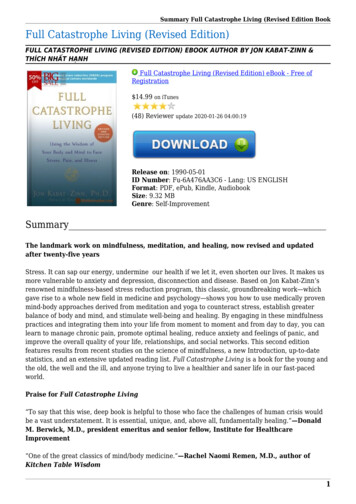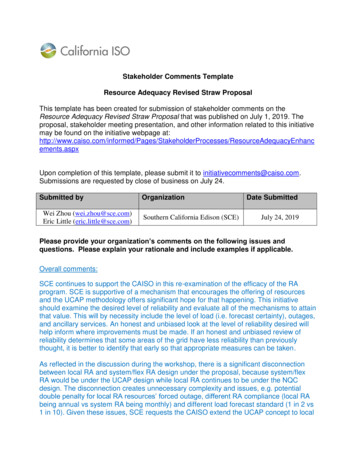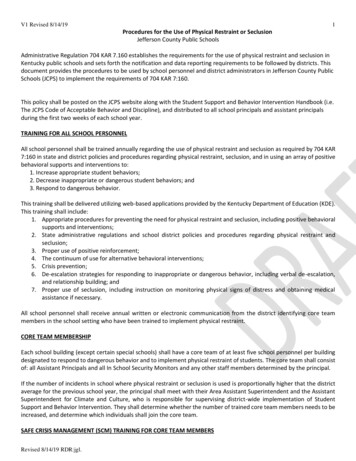
Transcription
V1 Revised 8/14/191Procedures for the Use of Physical Restraint or SeclusionJefferson County Public SchoolsAdministrative Regulation 704 KAR 7.160 establishes the requirements for the use of physical restraint and seclusion inKentucky public schools and sets forth the notification and data reporting requirements to be followed by districts. Thisdocument provides the procedures to be used by school personnel and district administrators in Jefferson County PublicSchools (JCPS) to implement the requirements of 704 KAR 7:160.This policy shall be posted on the JCPS website along with the Student Support and Behavior Intervention Handbook (i.e.The JCPS Code of Acceptable Behavior and Discipline), and distributed to all school principals and assistant principalsduring the first two weeks of each school year.TRAINING FOR ALL SCHOOL PERSONNELAll school personnel shall be trained annually regarding the use of physical restraint and seclusion as required by 704 KAR7:160 in state and district policies and procedures regarding physical restraint, seclusion, and in using an array of positivebehavioral supports and interventions to:1. Increase appropriate student behaviors;2. Decrease inappropriate or dangerous student behaviors; and3. Respond to dangerous behavior.This training shall be delivered utilizing web-based applications provided by the Kentucky Department of Education (KDE).This training shall include:1. Appropriate procedures for preventing the need for physical restraint and seclusion, including positive behavioralsupports and interventions;2. State administrative regulations and school district policies and procedures regarding physical restraint andseclusion;3. Proper use of positive reinforcement;4. The continuum of use for alternative behavioral interventions;5. Crisis prevention;6. De-escalation strategies for responding to inappropriate or dangerous behavior, including verbal de-escalation,and relationship building; and7. Proper use of seclusion, including instruction on monitoring physical signs of distress and obtaining medicalassistance if necessary.All school personnel shall receive annual written or electronic communication from the district identifying core teammembers in the school setting who have been trained to implement physical restraint.CORE TEAM MEMBERSHIPEach school building (except certain special schools) shall have a core team of at least five school personnel per buildingdesignated to respond to dangerous behavior and to implement physical restraint of students. The core team shall consistof: all Assistant Principals and all In School Security Monitors and any other staff members determined by the principal.If the number of incidents in school where physical restraint or seclusion is used is proportionally higher that the districtaverage for the previous school year, the principal shall meet with their Area Assistant Superintendent and the AssistantSuperintendent for Climate and Culture, who is responsible for supervising district-wide implementation of StudentSupport and Behavior Intervention. They shall determine whether the number of trained core team members needs to beincreased, and determine which individuals shall join the core team.SAFE CRISIS MANAGEMENT (SCM) TRAINING FOR CORE TEAM MEMBERSRevised 8/14/19 RDR:jgl.
V1 Revised 8/14/192The core team, except school resource officers and other sworn law enforcement officers, shall receive additional yearlySafe Crisis Management (SCM) training. SCM is an internationally recognized crisis intervention training programcopyrighted by JKM Training Incorporated, and is the only program authorized by JCPS for training core team membersand other school staff.Core team members shall receive SCM training in the following areas:1. Appropriate procedures for preventing the use of physical restraint and seclusion except as permitted by thisadministrative regulation and school district procedures;2. A description and identification of dangerous behaviors that may indicate the need for physical restraint andmethods for evaluating the risk of harm in individual situations, in order to determine whether the use of physicalrestraint is safe and warranted;3. Simulated experience of administering and receiving physical restraint, and instruction regarding the effect on theperson physically restrained, including instruction on monitoring physical signs of distress and obtaining medicalassistance;4. Instruction regarding documentation and notification requirements and investigation of injuries; and5. Demonstration by core team members of proficiency in the prevention and use of physical restraint.JCPS utilizes SCM when physical restraint is necessary. SCM training covers crisis extensive de-escalation and physicalintervention techniques that may be used by staff to prevent students from injury to self or others. SCM techniques aredesigned to use the least restrictive measures necessary for each individual student and situation.1. Initial Standard SCM Trainee Traininga. Prior to participating in the use of SCM, an initial training of 12 hours must be completed; (6 hours oftheory delivered via JKM’s online learning course or by the trainer and 6 hours of physical intervention).The online theory learning course shall be completed within 30 days of being registered for the courseand at least one day prior to receiving training on SCM emergency physical interventions); orb. Prior to participating in the use of SCM, an initial training of 18 hours must be completed (6 hours oftheory delivered via JKM’s online learning course or by the trainer and 12 hours of physical interventionwhich includes side assists). The online theory learning course shall be completed within 30 days ofbeing registered for the course and at least one day prior to receiving training on SCM emergencyphysical interventions);c. All participants must pass a physical skill test with a score of 85% or better;d. All participants must pass a written test with a score of 85% or better: ; ande. In the event a participant is temporarily unable to participate in SCM training the participant mustprovide a physician’s statement citing the reason he/she is unable to participate. Participants unable toparticipate in SCM review classes due to a medical/physical condition must still attend the session theyare due to maintain their training/knowledge level.2. Ongoing SCM Traininga. All relevant staff will be required to continue their SCM training in verbal de-escalation and safe crisisintervention through their attendance and participation in annual practice, annual training and passing ayearly written test on theory and physical skills test;b. Approximately 6 months after last certification date, participants must attend an annual 4 hour practicewhich will consist of de-escalation techniques and the review of physical skills.c. Once per year, participants must attend a 6 hour re-certification (Standard SCM Training) or 12 hourrecertification (All Inclusive SCM training) class to maintain their skill level training (3 hours of theorydelivered via JKM’s online learning course or by a JCPS trainer and 3-9 hours of physical interventiondepending on the curriculum training needed). The online theory learning course must be completedwithin 30 days of being registered for the course and at least one day prior to receiving training on SCMemergency physical interventions); andd. If a participant misses a annual review class he/she will be required to contact one of the SCM trainersto make arrangements for a make-up session;Revised 8/14/19 RDR:jgl.
V1 Revised 8/14/193.4.5.6.3e. If a participant doesn’t attend a practice and/or re-certification class annually he/she will receive arevocation notice and will no longer be considered trained in SCM and the individuals must completethe initial training again; andf. Safe Crisis Management may be performed individually or as a team:i. The only individual or team techniques that may be used are those approved by JKM TrainingInc. and taught by JCPS Safe Crisis Management Trainers; andii. When a team technique is to be used a team leader must be chosen.Safe Crisis Management trainers will:a. Be certified in SCM in the JCPS district training for no less than 6 months;b. Receive Safe Crisis Management Coordinators permission to register after receiving permission fromtheir Building Administrators;c. Complete the 5 day JKM training for Safe Crisis Management and receive an Instructor’s Certificate;d. Complete a re-certification class yearly and maintain an Instructor’s Certificate;e. Meet with the Safe Crisis Management Coordinator prior to training at any JCPS facility;f. Give a copy of their certificate from JKM to the Safe Crisis Management Coordinator to keep on fill incentral office;g. Provide any data requested by the Safe Crisis Management Coordinator;h. Stay in contact with and report to the Safe Crisis Management Coordinator for updated information orpolicy and procedures changes;i. Contact the Safe Crisis Management Coordinator with in twenty four hours of any major incidents thathave taken place in JCPS related to the use of Safe Crisis Management;j. Come to trainers meeting no less the Twice a year; andk. Follow all of Jefferson County Public Schools Safe Crisis Management Policies and Procedures;Protocols for revocation or not receiving a JCPS staff’s SCM certificate will include but not limited to:a. Not completing the recertification course;b. Not passing the written test by 85%;c. Not passing the physical skills test by 85%;d. Not participating in an annual practice;e. Noncompliance of following the 704 KAR 7:160 uses of Restraint and Seclusion in public schools.Remember there is no pain compliance or aversive for behavior. (Aversive: tending to avoid or causingavoidance of a noxious or punishing stimulus);f. Not completing a re-certification class or passing it by 85%;g. Substantiated claims of injuries to students or staff;h. Substantiated claims of using SCM as a punishment without the student causing harm to self or others.i. A Trainer has the discretion to give an individual a warning letter for minor infractions of SCM policy andprocedures, that they have used SCM in a negative way; andj. A Trainer will send a revocation letter stating an individual can no longer use SCM if they have purposelymisused Safe Crisis Management with the intent to punish or hurt a student.An individual will be given the choice to take the two day course again for SCM if it is because they cannot passthe written test by 85%, cannot pass the physical skills test by 85%, and/or have missed an annual practicesession.Any Safe Crisis Management trained individual that refuses to follow the state 704 KAR 7:160 of using SCM forother than harm to self or others, and chooses to use SCM with the intent to punish and harm a student will losetheir SCM certification permanently and will be ask not to put hands on students.USE OF PHYSICAL Restraint1. Physical restraint techniques shall be used only by trained core team members, with the following limitedexception:a. Use of physical restraint by all school personnel is permitted when a student’s behavior poses an imminentdanger of physical harm to self or others in clearly unavoidable emergency circumstances. In suchsituations, staff who have not had core team training can physically restrain students, but shall summoncore trained school personnel as soon as possible.Revised 8/14/19 RDR:jgl.
V1 Revised 8/14/1942. Physical restraint may only be implemented if:a. The student’s behavior poses an imminent danger of physical harm to self or others and as permittedunder KRS 503.050, 503.070, and 503.110;b. The physical restraint does not interfere with the student’s ability to communicate in the student’sprimary language or mode of communication, unless the student uses sign language or an augmentativemode of communication as the student’s primary mode of communication and the implementerdetermines that freedom of the student’s hands for brief periods during the restraint appears likely toresult in physical harm to self or others;c. The student’s physical and psychological well-being is monitored for the duration of the physical restraint;d. Less restrictive behavioral interventions have been ineffective in stopping the imminent danger of physicalharm to self or others, except in the case of a clearly unavoidable emergency situation posing imminentdanger of physical harm to self or others; ande. School personnel implementing the physical restraint are appropriately trained as core team members asrequired by Section 6(3) of 704 KAR 7:160, except to the extent necessary to prevent physical harm to selfor others in clearly unavoidable emergency circumstances where other school personnel intervene andsummon trained school personnel as soon as possible.f. When implementing a physical restraint, school personnel shall use only the amount of force reasonablybelieved to be necessary to protect the student or others from imminent danger of physical harm.g. The use of physical restraint shall end as soon as:i. The student’s behavior no longer poses an imminent danger of physical harm to self or others; orii. A medical condition occurs putting the student at risk of harm.3. Physical restraint is prohibited in the following circumstances:a. As a means of punishment;b. To force compliance or to retaliate;c. As a substitute for appropriate educational or behavioral support;d. To prevent property damage in the absence of imminent danger of serious physical harm to self or others;e. As a routine school safety measure;f. As a convenience for staff; org. As a substitute for timeout.4. Physical Restraint is to be a therapeutic response to the needs of the student who is endangering himself orothers.5. When implementing a physical restraint school personnel shall use only the amount of force reasonably believedto be necessary to protect the student or others from imminent danger of serious harm to self or others.6. The use of physical restraint shall end as soon as the student’s behavior no longer poses an imminent danger ofserious physical harm to self or others or a medical condition occurs putting the student at risk of harm.7. When implementing a physical restraint school personnel shall use only the amount of force reasonably believedto be necessary to protect the student or others from imminent danger of serious harm to self or others.8. SCM techniques are designed to decrease the likelihood of injury to students and staff. Prevention of injury to allconcerned is our primary goal.9. School Personnel are prohibited from imposing the following on any student at any time:a. Mechanical restraint;b. Chemical restraint;c. Aversive behavioral interventions;d. Physical restraint that is life threatening;e. Prone or Supine restraint;f. Physical restraint if they know that physical restraint is contraindicated based on a student’s disability,health care needs, or medical or physical condition; andg. Pain compliance will not be used on any JCPS Student.10. Permitted SCM Emergency Physical Safety InterventionsThe following techniques are permitted for use by trained members of the core team.Revised 8/14/19 RDR:jgl.
V1 Revised 8/14/195a. Individual assists include:i. Cradle Assistii. Cross Arm Assistiii. Shoulder Assistiv. Upper Torso Assistv. Cradle Transition to the floor Assistvi. Upper Torso Transition to the floor Assistvii. Seated/kneeling Cradle Assistviii. Seated/Kneeling Upper Torso Assistb. Multiple Person Team Assists include:i. Standing Bicep Assistii. Seated/Kneeling Bicep Assistiii. Standing Upper Torso Assistiv. Seated/kneeling Upper Torso Assistv. Hook Assistvi. Side assist (Certain Special Schools Only) Requires All Inclusive SCM Training (18 hours for initialand 9 hours for recertification)c. Escapesi. Escape Front Chokeii. Escape Rear Chokeiii. Escape Forearm Chokeiv. Escape Hair Pullsv. Escape Wrist Grabsvi. Escape Bitesvii. Escape Front Bear Hugviii. Escape Back Bear Hugd. Team TransportsWhen it is necessary for a team to transport a student, there are three approved team transporttechniques:i. Cradle Assist transportii. Hook Carry Assist transportUSE OF SECLUSION1. Seclusion may only be implemented if:a. The student’s behavior poses an imminent danger of physical harm to self or others;b. The student is visually monitored for the duration of the seclusion;c. Less restrictive interventions have been ineffective in stopping the imminent danger of physical harm toself or others; and. School personnel implementing the seclusion are appropriately trained to use seclusion.2. Seclusion shall not be used in a public school or educational program:a. As punishment or discipline;b. To force compliance or to retaliate;c. As a substitute for appropriate educational or behavioral support;d. To prevent property damage in the absence of imminent danger of physical harm to self or others;e. As a routine school safety measure;f. As a convenience for staff; org. As a substitute for timeout.3. The use of seclusion shall end as soon as:a. The student’s behavior no longer poses an imminent danger of physical harm to self or others; orb. A medical condition occurs putting the student at risk of harm.4.A setting used for seclusion shall:a. Be free of objects and fixtures with which a student could inflict physical harm to self or others;Revised 8/14/19 RDR:jgl.
V1 Revised 8/14/196b. Provide school personnel a view of the student at all times;c. Provide adequate lighting and ventilation;d. Be reviewed by district administration to ensure programmatic implementation of guidelines and datarelated to its use;e. Have an unlocked and unobstructed door; andf. Have at least an annual fire and safety inspection.REQUIRED DOCUMENTATION OF PHYSICAL RESTRAINTS AND SECLUSIONS1. All physical restraint and seclusions shall be documented in the Infinite Campus student data system. Schoolpersonnel designated as being responsible for maintaining behavior records shall receive annual training in theprocedures established by KDE to properly enter data regarding the use of restraint and seclusion.2. The student must be checked for injuries and a Student Injury Form must be completed immediately if injuriesare found.3. All staff involved in or witnesses the use of SCM Emergency Safety Procedures of any restraint must complete anelectronic Student Behavior Response Form before leaving the building.4. All physical restraints and seclusions shall be documented by a written record of each use of seclusion orphysical restraint and be maintained in the student’s education record.5. The physical restraint or seclusion record shall be completed by the end of the next school day following the useof seclusion or physical restraint.6. Each record of use of physical restraint or seclusion shall be reviewed by an interview with the student and shallinclude:a. The student’s name;b. A description of the use of a physical restraint or seclusion and the student behavior that resulted in thephysical restraint or seclusion;c. The date of the physical restraint or seclusion and school personnel involved;d. The beginning and ending times of the physical restraint or seclusion;e. A description of any events leading up to the use of physical restraint or seclusion including possiblefactors contributing to the dangerous behavior;f. A description of the student’s behavior during physical or seclusion;g. A description of techniques used in physically restraining or secluding the student and any otherinteractions between the student and school personnel during the use of physical restraint or seclusion;h. A description of any behavioral interventions used immediately prior to the implementation of physicalrestraint or seclusion;i. A description of any injuries to students, school personnel, or others;j. A description as to how the student’s behavior posed an imminent danger of physical harm to self orothers;k. The date the parent was notified;l. A description of the effectiveness of physical restraint or seclusion in de-escalating the situation;m. A description of the school personnel response to the dangerous behavior;n. A description of the planned positive behavioral interventions which shall be used to reduce the futureneed for physical restraint or seclusion of the student; ando. For any student not identified as eligible for services under either Section 504 of the Rehabilitation Actor the Individuals with Disabilities Education Act, documentation of a referral under either law ordocumentation of the basis for declining to refer the student.REQUIRED NOTIFICATIONS AND COMMUNICATIONS REGARDING PHYSICAL RESTRAINTS AND SECLUSIONS1. In addition to appropriate documentation in Infinite Campus, in the event of event of death, substantial risk ofdeath, extreme physical pain, protracted and obvious disfigurement or protracted loss or impairment of thefunction of a bodily member, organ, or mental faculty resulting from the use of physical restraint or seclusion:Revised 8/14/19 RDR:jgl.
V1 Revised 8/14/192.3.4.5.6.7.8.9.7a. The principal or other school administrator shall immediately notify the Assistant Superintendent forClimate and Culture, Area Assistant Superintendent and Supervisor of Safe Crisis Management, who isresponsible for supervising district-wide implementation of Student Support and Behavior Intervention;andb. Within 24 hours, the Assistant Superintendent for Climate and Culture shall notify in writing theKentucky Department of Education and local law enforcement.For occurrences lasting longer than 20 minutes, staff will contact the student’s legal guardian or emergencycontact person for assistance. If contact cannot be made, the Building Principal or Designee will make thedecision to call for other assistance such as the Police or Emergency Medical Persons.Parents/Guardians must be notified when a SCM physical restraint or seclusion has been implemented withtheir child.If the student is not an emancipated youth, the parent of the student shall be notified of the physical restraintand seclusion verbally or through electronic communication, if available to the parent, as soon as possible withintwenty-four (24) hours of the incident.a. If the parent cannot be reached within twenty-four (24) hours, a written communication shall be mailedto the parent via U.S. mail.b. The parent will be notified at the time of communication of their right to be part of the debriefing.The principal of the school shall be notified of the seclusion or physical restraint as soon as possible, but nolater than the end of the school day on which it occurred.A debriefing session shall be held as soon as possible after the imposition of physical restraint or seclusionupon a student with the student and/or parent at parent request. The following persons shall participate inthe debriefing session:c. The implementer of the physical restraint or seclusion;d. At least two (2) of any other school personnel who were in the proximity of the student immediatelybefore or during the physical restraint or seclusion;e. The parent of an unemancipated student if a parent request to attend;f. The student, if the parent requests, or if the student is an emancipated youth; andg. Appropriate supervisory and administrative school personnel, which may include appropriateAdmissions and Release Committee members, Section 504 team members, or response to interventionteam members.The debriefing session shall occur as soon as practicable, but not later than five (5) school days following therestraint or seclusion and/or request of the parent or the emancipated youth, unless delayed by writtenmutual agreement of the parent or emancipated youth and the school.The debriefing session shall include:h. Identification of the events leading up to the seclusion or physical restraint;i. Consideration of relevant information in the student’s records and information from teachers, parents,other school district professionals, and the student;j. Planning for the prevention and reduction of the need for seclusion or physical restraint, withconsideration of recommended appropriate positive behavioral supports and interventions to assistschool personnel responsible for implementing the student’s IEP, or Section 504 plan, or response tointervention plan, if applicable, and consideration of whether positive behavioral supports andinterventions were implemented with fidelity; andk. For any student not identified as eligible for services under either Section 504 of the Rehabilitation Actor the Individuals with Disabilities Education Act, documentation of a referral under either law ordocumentation of the basis for declining to refer the student.l. All documentation utilized in the debriefing session shall become part of the student’s education record.After the debriefing session is held, a parent of legal guardian who is not satisfied with the outcome may submita complaint to the Assistant Superintendent for Climate and Culture, who is responsible for supervising districtwide implementation of Student Support and Behavior Intervention. The Assistant Superintendent or designeeshall to investigate the circumstances surrounding the physical restraint or seclusion, make written findings, andif appropriate, take corrective action.Revised 8/14/19 RDR:jgl.
V1 Revised 8/14/198DATA COLLECTION AND REVIEW1. The following data shall be reported by the district in the Infinite Campus student information system related toincidents of physical restraint and seclusion:a. Aggregate number of uses of physical restraint;b. Aggregate number of students placed in physical restraint;c. Aggregate number of uses of seclusion;d. Aggregate number of students placed in seclusion;e. Aggregate number of instances of substantial risk of death, extreme physical pain, protracted and obviousdisfigurement or protracted loss or impairment of the function of a bodily member, organ, or mentalfaculty to students related to physical restraint and seclusion;f. Aggregate number of instances of substantial risk of death, extreme physical pain, protracted and obviousdisfigurement or protracted loss or impairment of the function of a bodily member, organ, or mentalfaculty to school personnel related to physical restraint and seclusion; andg. Aggregate number of instances in which a school resource officer or other sworn law enforcement officeris involved in the physical restraint or seclusion of a student.2. Assistant Superintendent for Climate and Culture and members of the Behavior Support and InterventionImplementation Team shall:a. Review data regarding physical restraints and seclusions at least twice monthly to:i. Inform the development and implementation of strategies to ensure effective implementation;ii. Ensure that procedures designed to ensure the safety of all students school personnel, and visitorsare being followed with fidelity; andiii. To identify schools in need of additional supportb. Review existing policies and procedures at least annually to determine whether amendments are needed.DEFINTIONS (from 704 KAR 7:160)(1) "Aversive behavioral interventions" means a physical or sensory intervention program intended to modifybehavior that the implementer knows would cause physical trauma, emotional trauma, or both, to astudent even when the substance or stimulus appears to be pleasant or neutral to others and may includehitting, pinching, slapping, water spray, noxious fumes, extreme physical exercise, loud auditory stimuli,withholding of meals, or denial of reasonable access to toileting facilities.(2) "Behavioral intervention" means the implementation of strategies to address behavior that is dangerous orinappropriate, or otherwise impedes the learning of the students.(3) "Chemical restraint" means the use of medication to control behavior or restrict a student’s freedom ofmovement that includes over-the-counter medications used for purposes not specified on the label butdoes not include medication prescribed by a licensed medical professional and supervised by qualified andtrained individuals in accordance with professional standards.(4) "Dangerous behavior" means behavior that presents an imminent danger of physical harm to self or othersbut does not include inappropriate behaviors such as disrespect, noncompliance, insubordination, or out ofseat behaviors.(5) "De-escalation" means the use of behavior management techniques intended to:a. Mitigate and defuse dangerous behavior of a student; orb. Reduce the imminent danger of physical harm to self or others.(6) "Emancipated youth" means a student under the age of eighteen (18) who is or has been married or hasBy court order or otherwise been freed from the care, custody, and control of the student’s parents.(7) "Emergency" means a sudden, urgent occurrence, usually unexpected but sometimes anticipated, thatrequires immediate action.(8) "Mechanical restraint" means the use of any device or equipment to restrict a student’s freedom ofmovement, but does not include:a. A device implemented by trained school personnel or utilized by a student that has been prescribedby an appropriate medical or related services professional that is used for the specific and approvedpurposes for which the device was designed;Revised 8/14/19 RDR:jgl.
V1 Revised 8/14/199b. An adaptive device or mechanical support used to achieve proper body position, balance, oralignment to allow greater freedom of mobility than would be possible without the use of thedevice or mechanical support;c. A vehicle safety restraint if used as intended during the transport of a student in a moving vehicle;d. Restraint for medical immobilization; ore. An orthopedically prescribed device that permits a student to participate in activities without risk ofharm.(9) "Parent" means a natural parent, a guardian, or an individual acting as a parent in the absence of a parentor a guardian of the stu
SAFE CRISIS MANAGEMENT (SCM) TRAINING FOR CORE TEAM MEMBERS . V1 Revised 8/14/19 Revised 8/14/19 RDR:jgl. 2 The core team, except school resource officers and other sworn law enforcement officers, shall receive additional yearly Safe Crisis Management (SCM) training. SCM is an internationally recognized crisis intervention training program
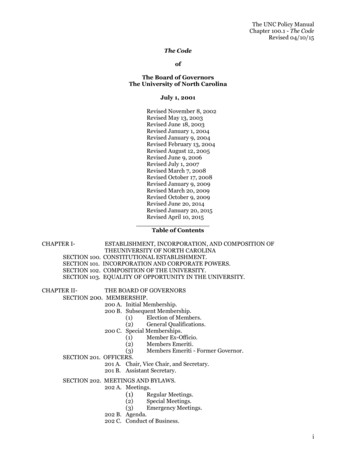


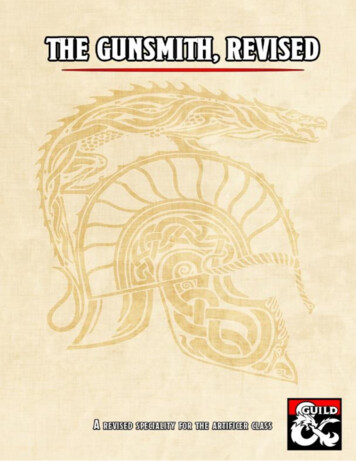
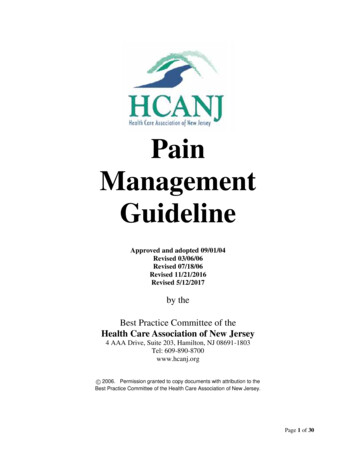
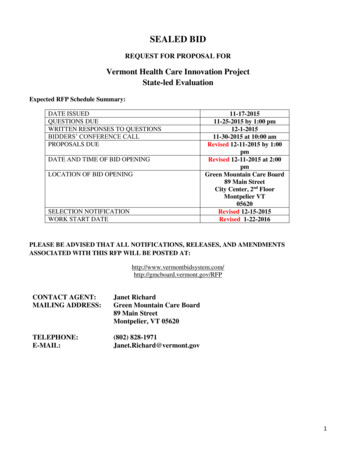

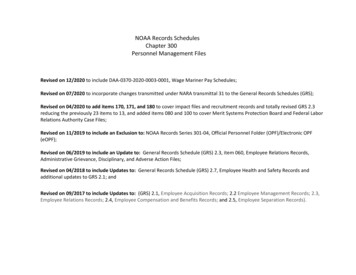
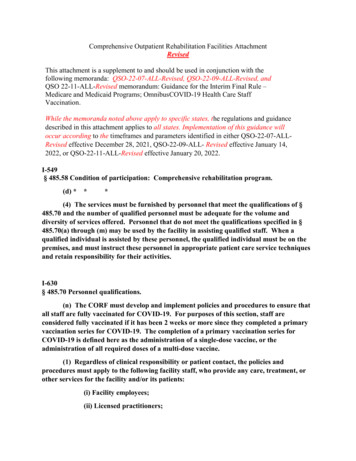
![firearms qualifications [PFP#730045656]](/img/59/firearms2003.jpg)
